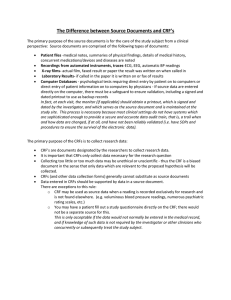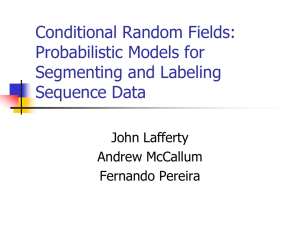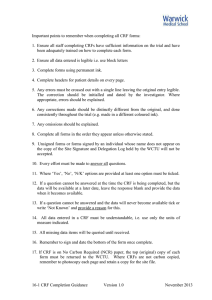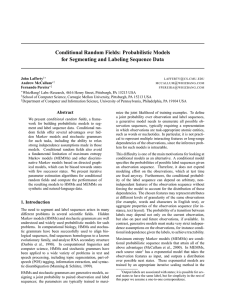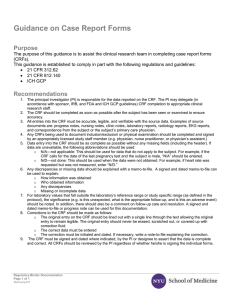Conditional Random Fields: Probabilistic Models for Segmenting and Labeling Sequence Data
advertisement
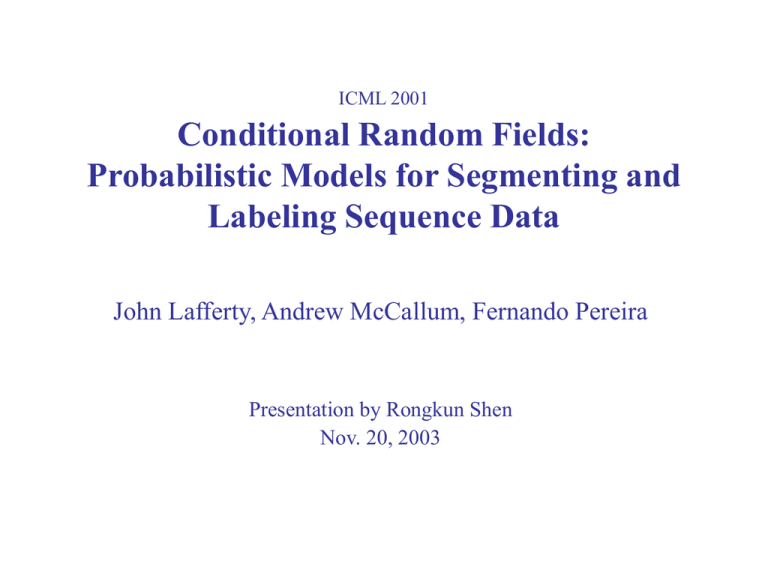
ICML 2001 Conditional Random Fields: Probabilistic Models for Segmenting and Labeling Sequence Data John Lafferty, Andrew McCallum, Fernando Pereira Presentation by Rongkun Shen Nov. 20, 2003 Sequence Segmenting and Labeling • Goal: mark up sequences with content tags • Application in computational biology – – – – DNA and protein sequence alignment Sequence homolog searching in databases Protein secondary structure prediction RNA secondary structure analysis • Application in computational linguistics & computer science – Text and speech processing, including topic segmentation, part-of-speech (POS) tagging – Information extraction – Syntactic disambiguation Example: Protein secondary structure prediction Conf: 977621015677468999723631357600330223342057899861488356412238 Pred: CCCCCCCCCCCCCEEEEEEECCCCCCCCCCCCCHHHHHHHHHHHHHHHCCCCEEEEHHCC AA: EKKSINECDLKGKKVLIRVDFNVPVKNGKITNDYRIRSALPTLKKVLTEGGSCVLMSHLG 10 20 30 40 50 60 Conf: 855764222454123478985100010478999999874033445740023666631258 Pred: CCCCCCCCCCCCCCCCCCCCCCCCCCHHHHHHHHHHHHHCCCCCCCCCCCCHHHHHHCCC AA: RPKGIPMAQAGKIRSTGGVPGFQQKATLKPVAKRLSELLLRPVTFAPDCLNAADVVSKMS 70 80 90 100 110 120 Conf: 874688611002343044310017899999875053355212244334552001322452 Pred: CCCEEEECCCHHHHHHCCCCCHHHHHHHHHHHHHCCEEEECCCCCCCCCCCCCCCCHHHH AA: PGDVVLLENVRFYKEEGSKKAKDREAMAKILASYGDVYISDAFGTAHRDSATMTGIPKIL 130 140 150 160 170 180 Generative Models • Hidden Markov models (HMMs) and stochastic grammars – Assign a joint probability to paired observation and label sequences – The parameters typically trained to maximize the joint likelihood of train examples Generative Models (cont’d) • Difficulties and disadvantages – Need to enumerate all possible observation sequences – Not practical to represent multiple interacting features or long-range dependencies of the observations – Very strict independence assumptions on the observations Conditional Models • Conditional probability P(label sequence y | observation sequence x) rather than joint probability P(y, x) – Specify the probability of possible label sequences given an observation sequence • Allow arbitrary, non-independent features on the observation sequence X • The probability of a transition between labels may depend on past and future observations – Relax strong independence assumptions in generative models Discriminative Models Maximum Entropy Markov Models (MEMMs) • • Exponential model Given training set X with label sequence Y: – Train a model θ that maximizes P(Y|X, θ) – For a new data sequence x, the predicted label y maximizes P(y|x, θ) – Notice the per-state normalization MEMMs (cont’d) • MEMMs have all the advantages of Conditional Models • Per-state normalization: all the mass that arrives at a state must be distributed among the possible successor states (“conservation of score mass”) • Subject to Label Bias Problem – Bias toward states with fewer outgoing transitions Label Bias Problem • Consider this MEMM: • P(1 and 2 | ro) = P(2 | 1 and ro)P(1 | ro) = P(2 | 1 and o)P(1 | r) P(1 and 2 | ri) = P(2 | 1 and ri)P(1 | ri) = P(2 | 1 and i)P(1 | r) • Since P(2 | 1 and x) = 1 for all x, P(1 and 2 | ro) = P(1 and 2 | ri) In the training data, label value 2 is the only label value observed after label value 1 Therefore P(2 | 1) = 1, so P(2 | 1 and x) = 1 for all x • However, we expect P(1 and 2 | ri) to be greater than P(1 and 2 | ro). • Per-state normalization does not allow the required expectation Solve the Label Bias Problem • Change the state-transition structure of the model – Not always practical to change the set of states • Start with a fully-connected model and let the training procedure figure out a good structure – Prelude the use of prior, which is very valuable (e.g. in information extraction) Random Field Conditional Random Fields (CRFs) • CRFs have all the advantages of MEMMs without label bias problem – MEMM uses per-state exponential model for the conditional probabilities of next states given the current state – CRF has a single exponential model for the joint probability of the entire sequence of labels given the observation sequence • Undirected acyclic graph • Allow some transitions “vote” more strongly than others depending on the corresponding observations Definition of CRFs X is a random variable over data sequences to be labeled Y is a random variable over corresponding label sequences Example of CRFs Graphical comparison among HMMs, MEMMs and CRFs HMM MEMM CRF Conditional Distribution If the graph G = (V, E) of Y is a tree, the conditional distribution over the label sequence Y = y, given X = x, by fundamental theorem of random fields is: p (y | x) exp k f k (e, y |e , x) k gk (v, y |v , x) vV ,k eE,k x is a data sequence y is a label sequence v is a vertex from vertex set V = set of label random variables e is an edge from edge set E over V fk and gk are given and fixed. gk is a Boolean vertex feature; fk is a Boolean edge feature k is the number of features (1 , 2 , , n ; 1 , 2 , , n ); k and k are parameters to be estimated y|e is the set of components of y defined by edge e y|v is the set of components of y defined by vertex v Conditional Distribution (cont’d) • CRFs use the observation-dependent normalization Z(x) for the conditional distributions: 1 p (y | x) exp k f k (e, y |e , x) k gk (v, y |v , x) Z (x) vV ,k eE,k Z(x) is a normalization over the data sequence x Parameter Estimation for CRFs • The paper provided iterative scaling algorithms • It turns out to be very inefficient • Prof. Dietterich’s group applied Gradient Descendent Algorithm, which is quite efficient Training of CRFs (From Prof. Dietterich) • First, we take the log of the equation log p ( y | x) eE,k k f k (e, y |e , x) g vV ,k k k (v, y |v , x) log Z (x) • Then, take the derivative of the above equation log p ( y | x) f ( e , y | , x) g ( v , y | , x) log Z (x) k k e k k v eE,k vV ,k • For training, the first 2 items are easy to get. • For example, for each k, fk is a sequence of Boolean numbers, such as 00101110100111. k f k (e, y |e , x) is just the total number of 1’s in the sequence. • The hardest thing is how to calculate Z(x) Training of CRFs (From Prof. Dietterich) (cont’d) • Maximal cliques y1 c1 y2 c1 c2 c2 y3 c3 y4 c3 c1 : exp( (y1 ,x) (y2 ,x) (y1,y 2 ,x)) c1 (y1,y 2 ,x) c2 : exp( (y3 ,x) (y2 ,y3 ,x)) c2 (y 2 ,y3 ,x) c3 : exp( (y4 ,x) (y3 ,y4 ,x)) c3 (y3 ,y4 ,x) Z (x) c1 (y1 ,y 2 ,x)c2 (y 2 ,y3 ,x)c3 (y3 ,y 4 ,x) y1 ,y 2 ,y3 ,y 4 c1 (y1 ,y 2 ,x) c2 (y 2 ,y3 ,x) c3 (y3 ,y 4 ,x) y1 y2 y3 y4 Modeling the label bias problem • In a simple HMM, each state generates its designated symbol with probability 29/32 and the other symbols with probability 1/32 • Train MEMM and CRF with the same topologies • A run consists of 2,000 training examples and 500 test examples, trained to convergence using Iterative Scaling algorithm • CRF error is 4.6%, and MEMM error is 42% • MEMM fails to discriminate between the two branches • CRF solves label bias problem MEMM vs. HMM • The HMM outperforms the MEMM MEMM vs. CRF • CRF usually outperforms the MEMM CRF vs. HMM Each open square represents a data set with α < 1/2, and a solid circle indicates a data set with α ≥ 1/2; When the data is mostly second order (α ≥ 1/2), the discriminatively trained CRF usually outperforms the HMM POS tagging Experiments POS tagging Experiments (cont’d) • Compared HMMs, MEMMs, and CRFs on Penn treebank POS tagging • Each word in a given input sentence must be labeled with one of 45 syntactic tags • Add a small set of orthographic features: whether a spelling begins with a number or upper case letter, whether it contains a hyphen, and if it contains one of the following suffixes: -ing, -ogy, -ed, -s, -ly, -ion, -tion, -ity, -ies • oov = out-of-vocabulary (not observed in the training set) Summary • Discriminative models are prone to the label bias problem • CRFs provide the benefits of discriminative models • CRFs solve the label bias problem well, and demonstrate good performance Thanks for your attention! Special thanks to Prof. Dietterich & Tadepalli!
